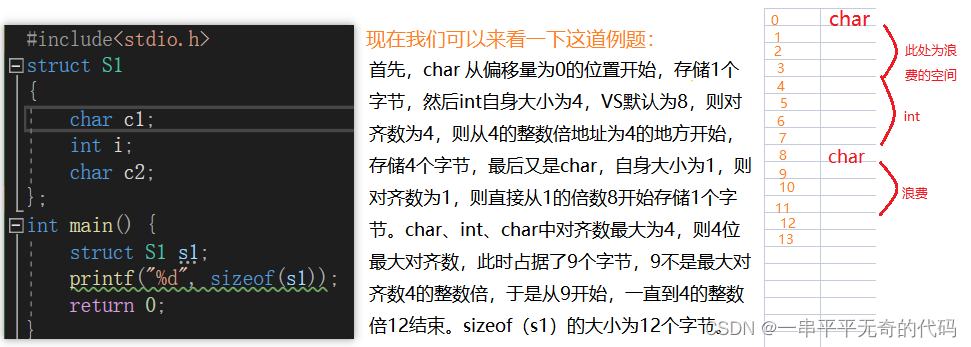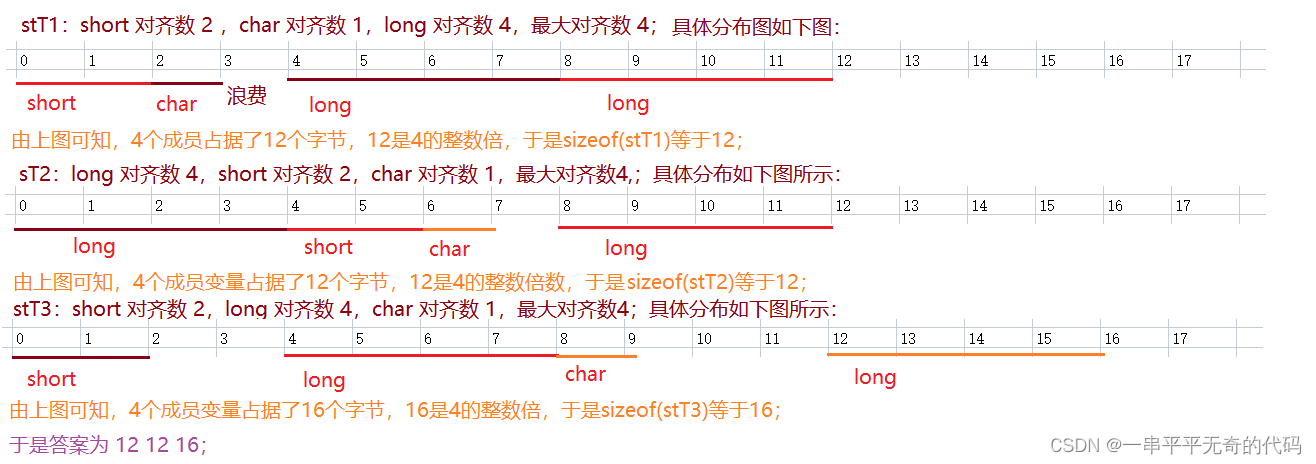

第一题:求sizeof(union Un)的大小
#include <stdio.h>
union Un
{
short s[7];
int n;
};
int main()
{ A.14
printf("%d\n", sizeof(union Un)); B.4
return 0; C.16
} D.18

第二题:默认对齐数为8字节,这个结构体所占的空间大小是多少字节
typedef struct{
int a;
char b; A.16
short c; B.9
short d; C.12
}AA_t; D.8

第三题:下面代码的结果是
#pragma pack(4)/*编译选项,表示4字节对齐 平台:VS2013。语言:C语言*/ //假设long 是4个字节 int main(int argc, char* argv[]) { struct tagTest1 { short a; char d; long b; long c; }; struct tagTest2 { long b; short c; char d; long a; }; struct tagTest3 { short c; long b; char d; long a; }; struct tagTest1 stT1; struct tagTest2 stT2; struct tagTest3 stT3; printf("%d %d %d", sizeof(stT1), sizeof(stT2), sizeof(stT3)); return 0; } #pragma pack()A.12 12 16 B.11 11 11 C.12 11 16 D.11 11 16

第四题:当A=2, B=3时,pointer分配多少个字节的空间。
#define MAX_SIZE A+B
struct _Record_Struct
{
unsigned char Env_Alarm_ID : 4;
unsigned char Para1 : 2;
unsigned char state;
unsigned char avail : 1;
}*Env_Alarm_Record;
struct _Record_Struct *pointer = (struct _Record_Struct*)malloc(sizeof(struct _Record_Struct) * MAX_SIZE);A.20 B.15 C.11 D.9

本题字节内存储方向为从高到低!

第五题:在X86下,小端字节序存储,有下列程序;输出结果是多少
#include<stdio.h> int main() { union { short k; char i[2]; }*s, a; s = &a; s->i[0] = 0x39; s->i[1] = 0x38; printf("%x\n", a.k); return 0; }A.3839 B.3938 C.380039 D.不确定

第六题:
下面代码的结果是:( )
enum ENUM_A
{
X1,
Y1,
Z1 = 255,
A1,
B1,
};
enum ENUM_A enumA = Y1;
enum ENUM_A enumB = B1;
printf("%d %d\n", enumA, enumB);A.1, 4 B.1, 257 C.2, 257 D.2, 5

所以enumA=1,enumB=257
第七题:下面代码的结果是
int main()
{
unsigned char puc[4];
struct tagPIM
{
unsigned char ucPim1;
unsigned char ucData0 : 1;
unsigned char ucData1 : 2;
unsigned char ucData2 : 3;
}*pstPimData;
pstPimData = (struct tagPIM*)puc;
memset(puc,0,4);
pstPimData->ucPim1 = 2;
pstPimData->ucData0 = 3;
pstPimData->ucData1 = 4;
pstPimData->ucData2 = 5;
printf("%02x %02x %02x %02x\n",puc[0], puc[1], puc[2], puc[3]);
return 0;
}A.02 03 04 05 B.02 29 00 00 C.02 25 00 00 D.02 29 04 00
#include<string.h>
#include<stdio.h>
int main()
{
unsigned char puc[4];
struct tagPIM
{
unsigned char ucPim1;// 一个字节
unsigned char ucData0 : 1;// 1个比特
unsigned char ucData1 : 2;// 2个比特
unsigned char ucData2 : 3;// 3个比特 总和两字节
}*pstPimData;
pstPimData = (struct tagPIM*)puc;
memset(puc, 0, 4);//将puc数组进行赋值 4个0
pstPimData->ucPim1 = 2; //将整形2截取并将0000 0010放入
pstPimData->ucData0 = 3; //将整形3截取并将1放入
pstPimData->ucData1 = 4; //将整形4截取并将00放入
pstPimData->ucData2 = 5; //将整形5截取并将101放入
//二进制最终形式为 00 00 00 10 00 10 10 01 00 00 00 00 00 00 00 00
printf("%02x %02x %02x %02x\n", puc[0], puc[1], puc[2], puc[3]); //02 29 00 00
return 0;
}
第八题:在32位系统环境,编译选项为4字节对齐,那么sizeof(A)和sizeof(B)是
struct A
{
int a;
short b;
int c;
char d;
};struct B
{
int a;
short b;
char c;
int d;
};A.16,16 B.13,12 C.16,12 D.11,16

























 627
627











 被折叠的 条评论
为什么被折叠?
被折叠的 条评论
为什么被折叠?










